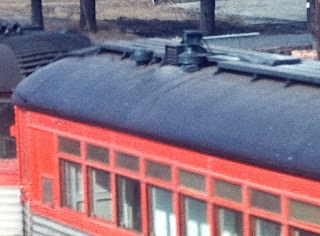A custom made lighting stick was made. What is unique about any dining car or a tavern-lounge car are the kitchen, passageways, dining areas, and other areas walled off within the car. Getting the correct amount of light into each area is important.
My light stick with bulbs about 1" apart allows for each of the area to receive the correct amount of lighting. In the passageway along the side of the kitchen the individual light bulbs were glued in a way so only the face of the bulb was showing. This reduced the amount of light. It also made the individual lights look the same as the bulbs were in the actual car. With the passageway being along an outside wall, it is easy to look into the model and see the ceiling plus the bulbs.
Constant
Voltage Unit & Wiring the Car
Below is a drawing of the wiring of my 415. Photos show
how the wiring was installed in the car.Cabs
Bulkheads
The 2 bulkheads should be installed.
Assembly of Car
The models can be assebmled in the same manner as the 2 coaches. Be sure all the parts are secure to the floor and/or glues in place.
Trucks
Before mounting the trucks, two 0.005” thick brass tabs
have to be made. This is my usual way of mounting non-powered trucks to a
model. The tabs are cut from a sheet of brass. Usually 2 holes are punched into
the thin brass with a pointed tool. One hole is small for the grounding wire.
The other hole has to be large enough for a 3-48 screw to pass through.Any sharp corners are rounded before the grounding wire is soldered to the brass tab. A spring with some give is placed over the 3-48 screw before it is inserted into the hole in the truck bolster. The 3-48 screw is then inserted into the brass tab and screwed down enough so it clears the bottom of the truck.
The spring holds the screw tight while keeping the truck
bolster in constant contact with the grounded brass tab. The screw-spring
arrangement prevents the model from wobbling as it travels down the track.
Couplers
The couplers can be mounted to the car. See the prior
posts on how to paint and treat the couplers for use.
Wiring of Coupler
There is a short wire to go to the lead car for power to
415. The end of the wire should have a piece of brass tubing soldered to it.
This piece of tubing will fit into the connection under the coupler of the lead
car. To prevent any accidental grounding of the brass tubing on the 415 a piece
of heat-shrink tubing should be installed on it.If the wire from 415 is short enough there should not be any need to secure the wire to 415’s coupler.
Uncoupling Pull
The 415 was built with a series of cars whose manufacturer
used a different uncoupling “lever” from the 2 Pullman built coaches. Instead a
“hand shaped” pull located in the handrail below and to the outside of the
anticlimber was used.See the First and Fastest issue with regards to the coach uncouplers. The “hand shaped” pull can be made from very thin wire and glued with ACC into location. Once the ACCcures paint the wire and the ACC a weather or grimy black.
Pilots
The pilots can be installed and painted a weathered or
grimy black.
Whistles and
Windshield Wipers
The 415 did not have horns mounted on the roof like most
rebuilt NSL cars. The car retained its whistle located above the motorman’s cab
position. A hole should be drilled for the pipe to the whistle in the upper
right hand (as you look at the window from the outside) corner. The whistle
painted a “brass” color can be installed.
The windshield wipers can be installed.
Cheers,
Ed


























